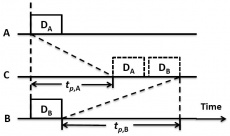DAP-MAC
From NUEESS
Contents |
Overview
The long propagation delay of underwater acoustic communications has made traditional handshaking-based medium access control (MAC) protocols inefficient for underwater sensor networks (UWSNs). We envision that this unique feature, although often taken as negative, can be leveraged to improve the parallelism between multiple senders, i.e., transmitting data simultaneously so as to achieve higher channel utilization. The proposed DAP-MAC is a novel delay-aware probability-based MAC protocol, which eliminates the handshaking process and utilizes concurrent transmissions to significantly improve the network throughput. Our extensive simulations demonstrate that DAP-MAC achieves better system throughput than the existing representative underwater MAC protocols.
The main features of DAP-MAC are summarized below.
- Concurrent Transmissions. The unique channel access compatibility relation, characterized by the distance difference between senders and their common intended receiver, is utilized to achieve concurrent transmissions and to improve the channel utilization significantly.
- Stochastic Transmission Strategy. The optimal stochastic transmission strategy eliminates the usage of inefficient handshaking, which is yielded by a utility-optimization framework maximizing the network throughput and maintaining minimal packet collisions.
- Distributive with Low Overhead. The optimal transmission strategy can be achieved distributively with only small control overhead, which makes DAP-MAC very suitable for long-delay and power-hungry UWSNs.
- Robust under Mobility. The run-time derived compatibility relation, the dynamically updated optimal transmission strategy, and the additional guard time in determining the compatibility, together enhance the adaptiveness of DAP-MAC to underwater network dynamics.
Motivation
We focus on leveraging the long propagation delay of underwater acoustic communications rather than being constrained by it in networking design. The non-neglectable propagation delay makes certain strict requirements in RF-based wireless networks unnecessary for underwater acoustic networks, such as the exclusive channel access.
In UWSNs, packets sent concurrently by different senders may arrive at their intended receiver at different times and can be decoded separately. The figure on the right shows an example where nodes A and B are sending packets to node C at the beginning of a slot in a time-slotted system. The two packets can arrive at C apart without collision, if certain condition is satisfied.
Design
Simulation Tools
The simulation tool of DAP-MAC is fully developed on the widely used network simulator OMNeT++, using OMNet++-4.3 with INET-1.99.4 extension. The DAP-MAC package will be provided upon release (coming soon).
| Whos here now: Members 0 Guests 0 Bots & Crawlers 1 |

